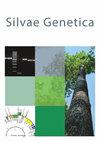The genetic basis of sex determination in Populus provides molecular markers across the genus and indicates convergent evolution
IF 1
4区 农林科学
Q3 FORESTRY
引用次数: 5
Abstract
Abstract Many dioecious angiosperms are trees, which only flower after years of vegetative development and do not usually exhibit marked secondary sexual dimorphism. Nevertheless, if the genetic basis of sex determination is known, the sex of an individual can be determined using molecular markers. Here, we report that in the genus Populus sect. Populus an XY system of sex determination, which is found in P. tremula and P. tremuloides, likely re-evolved from a ZW system present in P. alba, P. adenopoda and P. qiongdaoensis. Strikingly, this new XY system is mechanistically identical to the older system found in several species of the Populus sections Tacamahaca, Aigeiros and Turanga demonstrating a remarkable example of convergent evolution. In both XY systems, male-specific inversely repeated sequences appear to silence the ARR17 gene, which functions as a sex switch, via small interfering RNAs and DNA methylation. In the ZW system, female-specific copies of ARR17 appear to regulate dioecy. With this detailed information on the genetic basis of sex determination it was possible to develop molecular markers that can be utilized to determine the sex in seedlings and non-flowering trees of different poplar species. We used the female-specific ARR17 gene to develop a sex marker for P. alba and P. adenopoda. For P. grandidentata, we employed the male-specific ARR17 inverted repeat. Finally, we summarize previously described markers for P. tremula, P. tremuloides, P. trichocarpa, P. deltoides and P. nigra. These markers can be useful for poplar ecologists, geneticists and breeders.杨树性别决定的遗传基础提供了跨属的分子标记,表明趋同进化
许多雌雄异株被子植物是乔木,经过多年的营养发育后才开花,通常不表现出明显的次生两性二态性。然而,如果性别决定的遗传基础是已知的,个体的性别可以用分子标记来确定。在这里,我们报道了在白杨属和白杨科中发现的XY性别决定系统,可能是由白杨、腺足杨和琼道杨的ZW系统重新进化而来的。引人注目的是,这个新的XY系统在机制上与在Tacamahaca, Aigeiros和Turanga的几个杨种中发现的旧系统相同,证明了趋同进化的一个显着例子。在这两种XY系统中,男性特异性的反向重复序列似乎通过小干扰rna和DNA甲基化使ARR17基因沉默,ARR17基因起着性别开关的作用。在ZW系统中,ARR17的雌性特异性拷贝似乎调节雌雄异株。利用这一详细的性别决定遗传基础信息,可以开发用于确定不同杨树种苗和非开花树性别的分子标记。我们利用雌性特异性的ARR17基因开发了白藻和腺足藻的性别标记。对于桔梗,我们采用了雄性特异性的ARR17反向重复序列。最后,我们总结了先前描述的tremula P., tremuloides, P. trichocarpa, P. deltoides和P. nigra的标记。这些标记可为杨树生态学家、遗传学家和育种家提供参考。
本文章由计算机程序翻译,如有差异,请以英文原文为准。
求助全文
约1分钟内获得全文
求助全文
来源期刊

Silvae Genetica
农林科学-林学
CiteScore
2.20
自引率
10.00%
发文量
10
审稿时长
3 months
期刊介绍:
Silvae Genetica is an international peer reviewed journal with more than 65 year tradition and experience in all fields of theoretical and applied Forest Genetics and Tree breeding. It continues "Zeitschrift für Forstgenetik und Forstpflanzenzüchtung" (Journal of Forest Genetics and Forest Tree Breeding) founded by W. LANGNER in 1951.
 求助内容:
求助内容: 应助结果提醒方式:
应助结果提醒方式:


